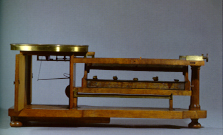
53 x 21.2 x 21.3
Iron, brass and wood
CAT. 1824 : M.II.118
Um pyrometro, pelo qual se podem observar as dilatações de varios corpos, ou a fogo nu, ou em banho de agoa quente: feito por Haas. Tem varias pertenças, que todas vão debaixo deste numero.
A pyrometer, by which it is possible to observe the dilation of various bodies, either in the naked flame, or in a bath of hot water. Made by Haas. It has various belongings that all go under this number.
"The action of fire on metals", as Nollet mentions in his Leçons de Physique Expérimentale, can be measured by an instrument called a pyrometer. The mechanism that works this apparatus is based on the multiplying effect of forces and of the amplitude of movements of the combination of cogwheels and worm -screws.
The system of the pyrometer's constituent gears is operated by the end of a metal bar, submerged in a receptacle of water, which is heated by little night lamps distributed along the reservoir. The bar, whose ends rest against two posts, expands as a consequence of the rise in temperature. One of the posts is fixed and the other is able to move, accompanying the end of the bar during expansion. This movement, slow and small, is amplified by the pyrometer through its set of cogwheels. These engage one another successively, the system ending by acting on a pointer that moves over a circular graduated panel mounted horizontally.
The dial of the apparatus is divided into 10 sectors, each of which is subdivided into 50 equal parts. The sensitivity of this instrument allows the expansion of the bar to be measured to within hundredths of a millimeter.
The number of turns made by the pointer is registered through a little window in the dial, under which turns a little calibrated disk, divided into 10 equal parts.
In Leçons de Physique Expérimentale, Nollet describes the experiment carried out. By heating bars of different metals, it was possible to record their behaviour, taking as a term of comparison, their increased length at determined time intervals.
This pyrometer was made in Lisbon in 1805, and the dial bears the signature of Jacob Bernard Haas.
Nollet, Jean-Antoine, Leçons de Physique Expérimentale, Paris, 1764, Vol. IV, Lec. XIV, Pl. 1, p.18, Fig 4.